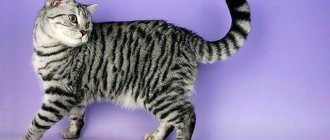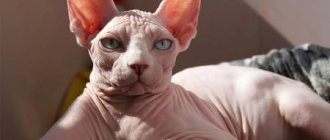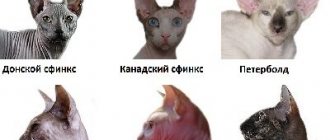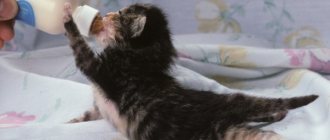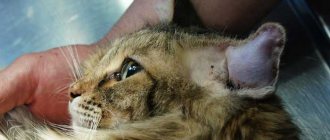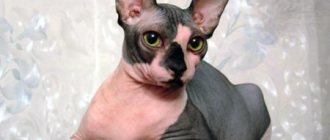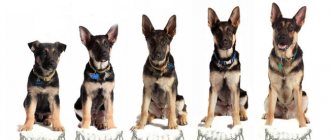Our participation in the development of Sphynx kittens
Eighty-five grams of weight and twelve centimeters of height - this is what small kittens have at birth.
Plus, at first glance, they are absolutely helpless: blind, deaf, unable to move independently. But this is only at first glance. But in fact, they already have an excellent sense of smell and find food on their own: their mother’s nipples. I would like to write in a separate line: only sphinxes up to three months old have blue eyes, one might even say bottomless. Charms!
Only three days will pass, and with the movement of their paws they cause the mother to release milk, and by the end of the week their weight will double. The eyes will open, a cat's reaction will appear: with the eyes, with attempts to perform actions. They will be able to sit confidently and move independently by the end of the month. But it’s impossible to call them helpless until this time: and the main thing here is that they understand and demonstrate the need to move, defend themselves, and get food.
Their teeth erupt at one month of age: if you are attentive, you will notice that on the thirty-second day, babies begin to try other foods in addition to mother's milk. Although a good mother continues to feed them with her milk for up to two months or even more.
Until the age of forty-five days, Sphynx babies are afraid to leave their mother. However, you will notice, and must definitely take into account when raising and training them, that this is the period when they become active and terribly playful before your eyes. Their favorite pastimes are active, outdoor games, especially wrestling.
In the third month, alas, your cat shows more interest not in the kittens, but in the cat. Nature is nature, you can’t argue with it. No matter how hard the kids try, she will not allow them to touch her nipples. There is only one way out: you need to learn to eat other foods, and not suck milk from your nipples, but lick it from a plate. You should know: for babies, in fact, this is a period of shock: they rush about, worry, and often tremble. But this passes quickly, especially if you show affection and attention.
It is you who must gradually increase the amount of additional kitten food. We especially draw the attention of those owners whose cats have large litters, or the cats themselves are weak, sick and cannot provide adequate nutrition to their children.
In general, you and I should know and notice that even by the end of the first month of a baby’s life, the mother begins to teach the children that soon she will not give them access to the nipples: she turns away from them, lies on her tummy, hides the nipples. Therefore, by the end of the third week, they should, of course, with your light hand, have a plate or saucer, it doesn’t matter, with a cat’s milk replacer. For the first two to three days, the dose should be one teaspoon per dose. Then start adding a little baby food. And so continue for a week. In the second week, feed one day a small amount of canned food (meat or fish).
It shouldn’t matter to you how much milk they receive from their mother, something else is important to you: they should receive food three to four times a day. When they reach six weeks of age, at each feeding they should receive three to four spoons (teaspoons, of course) of the food you prepared. Nutrition must be organized so that at the age of six to eight weeks they and we are ready to move away from mother's milk and feed on their own. It is advisable that you feed them four to five times a day.
The main question always arises: what to feed? The principle should be this: the “child” grows, and the amount of solid food added also increases: minced beef, boiled chicken and fish, canned food from a pet store. If we talk about water, then at first add more, and over time reduce its amount to a minimum. It’s better to put some water separately, so anyone who wants to can drink it themselves. It is very useful to feed them with omelet, but always with butter. In general, try to give a variety of food: try to ensure that there are as few whims as possible with food. From infancy, their taste should be determined in your favor. Remember: if they begin to diarrhea or do not eat your food, consult a doctor immediately.
When can kittens be considered not kittens, but adult cats? At six months. At this age, they are already ready for hunting, love relationships, and in general, living independently.” Maturing kittens begin to mark their territory at five months. By this time, their baby teeth will have already been replaced. And their mother begins to prepare to become a mother next time, unless, of course, you interfere with her.
Now let’s, in a concentrated form, define the main periods of development: from birth and, say, up to a year. Five to eleven days pass and the eyes open. But the ear canals will open in six to thirteen days. In the third week, teeth will erupt, and in the fourth, start feeding. In the seventh week you can give the first anthelmintic for the first time. Panleukopenia, or the first vaccination, is given at the age of nine weeks, or a week earlier or later. But plan the second one for the thirteenth week, or a week later or earlier. At the same time, you can change the owner. The fifth month is the time to get a rabies vaccination and a complete change of teeth. If you decide to castrate or sterilize your youngsters, this can be done within six months to a year, which is when puberty occurs. A rabies vaccination must be done every year, and after two years - panleukopenia (repeated vaccinations).
What is the difference between the Canadian Sphynx and the Don Sphynx?
The main difference between the Don Sphynx and the Canadian one is that the body of the latter is not completely bald, but there are other differences.
| Donskoy | Canadian |
| Young breed from Russia. | The breed originated in Canada. |
| The lack of hair is the result of crossing with breeds with smooth and short hair. | Lack of hair is recessive (suppressed). |
| The head of the representative of the breed has a wedge-shaped shape, a sloping forehead and sharply prominent cheekbones, eyes in the shape of almonds. | The skull is rounded, the features are smoothed, the forehead is relatively well defined, the eyes are large and lemon-shaped. |
| Many representatives have a mustache. | There are no mustaches. |
| There are species that are completely naked and have hair. | The body is covered with barely noticeable fluff. |
| The limbs are of medium length, which is why the sphinx is not an important jumper. | The legs are long, allowing them to jump quite long distances. |
| The tail is straight, long and flexible. | The tail tapers towards the end and ends with a small fluffy tassel. |
| The skin is usually smooth, without wrinkles. | There are folds of skin on the body, especially in the neck and armpits. |
| Very hardy with good health. | The pain threshold is reduced, health is poor. |
What should the weight of a sphinx be?
Many owners really like it when their pet gets fat.
He seems funny at first glance.
In fact, obesity is our worst enemy.
The animal becomes inactive, and there is a severe strain on the cardiovascular system.
Overfeeding a cat will not make him happy.
Therefore, it is important to know the normal weight of your Sphynx and balance the daily food intake, cautioning against overfeeding and obesity.
The normal weight of the Sphynx does not differ from the weight of other cats - 2-5 kg. But they have an important difference.
Since Sphynx cats are hairless, compared to shaggy cats, they have a much greater body heat loss. The expended energy must be replenished. This results in increased metabolism and a greater need for food. In general, it costs a lot to maintain normal body temperature.
History of the Canadian Sphynx breed
Although the breed is quite young, the existence of hairless cats is mentioned in the annals of various civilizations. The thing is that “bald” offspring can appear from completely ordinary parents as a result of a natural mutation. Most often, such animals were considered an anomaly and were discarded by humans.
There is evidence of the emergence in South America of an entire population of graceful creatures with amber-colored eyes. True, unlike Canadians, they could be partially covered with wool during the cold season, and wore mustaches all year round. It is impossible to judge the genetic characteristics of these animals today, since the breed has disappeared. The last individuals whose existence is documented lived in the 20s of the last century, but then “Inca cats,” as the Mexicans called them, did not interest professional breeders.
40 years have passed, and much further north, in the Canadian province of Ontario, the owner of a black and white short-haired cat named Elizabeth was surprised to find an unusual specimen in her pet’s litter. The kitten was given the name Prune (English: Prune) and, upon reaching maturity, was crossed with its own mother. The first experiments seemed successful, but already in the early 1970s the line was interrupted.
Around the same time, a new stage in the history of the breed began. In one of the catteries in Baden, Minnesota, two cats were devoid of fur at once. All modern elite lines trace their pedigree back to them, although the selection process, of course, included cats of different breeds. The best results were achieved by working with Devon Rexes; “naked” kittens, which were again discovered among our northern neighbors, actively participated in the creation of the breed. They were originally called “Canadian hairless cats,” but enthusiasts wanted something more sonorous and drew parallels with the oldest surviving monumental sculpture - the Egyptian Great Sphinx, which guards the peace of ancient rulers in Giza.
Recognition from international felinological organizations did not come immediately. There were concerns that the mutation was causing serious health problems. When time showed the inconsistency of these theories, The International Cat Organization (TICA) was the first to allow Sphynx dogs to participate in its exhibitions in 1986. After 6 years, champion status was received from the Canadian Cat Association (CCA), but the breed standard according to the authoritative The Cat Fanciers' Association (CFA) was approved relatively recently, in 2002.
What should be a normal weight for a Sphynx?
If an ordinary cat, on average, needs up to 400 g of food per day, then the Sphynx can eat up to 600 g. Of course, the ambient temperature plays an important role.
If you take your Sphynx for walks in the fresh air, do not forget to wear clothes for him. It is very important to take proper care of your Sphynx during the cold season.
Is my Sphynx thin or fat?
To help you determine whether your pet has a normal weight, we have compiled a table:
Thanks to the table, you can easily determine whether your pet has weight abnormalities.
If your cat's weight shifts in one direction or another, please contact your veterinarian to examine your pet and adjust not only its diet, but also, possibly, its lifestyle and routine.
The weight of an animal is an indicator of the health of the body as a whole. Monitor your pet's weight and your cat will be healthy and happy!
More information on What should the weight of a Sphynx be?
You can receive by leaving a comment.
Canadian Sphynx: description, photo, care, character, price
The Canadian Sphynx is a breed of hairless cat. It must be said that these animals are no longer just pets in the classical sense.
The mutation changed not only the appearance of the Canadian sphinxes, but also their disposition, thanks to which they turned from a wayward beast of prey into a good-natured creature who adores their owners.
It is believed that this breed is one of the most loving among all cats in general.
History of the origin of cats of the Canadian Sphynx breed
It is clear that the most obvious feature of Sphynx cats is the lack of fur, as well as cute folds all over the body. These animals began to conquer the hearts of cat lovers relatively recently.
In 1966, the first Sphynx kitten was born in Canada, although no one suspected it at the time. The only hairless baby from the entire litter of the most ordinary cat received the nickname Prune, and his further crossing helped in preserving the hairless gene.
Then the breeders were never able to fully understand how the sphinxes appeared. It would seem that everyone understands what a new breed looks like, but how can breed stability be achieved?
This problem persisted for a decade, and then the Epidermis appeared! This is the name given to a Sphynx kitten born in Minnesota.
Soon a cat of a similar species appears here, and later, the two of them end up in a nursery, these individuals give rise to the breed and become the ancestors of the Canadian Sphynxes.
When studying the history of this breed in detail, one should remember about Bambi. This hairless black and white cat was found on one of the streets of Toronto in the seventies of the twentieth century. Everyone was talking about how handsome he was.
Bambi's characteristics completely coincided with his name. However, he was a street animal who had suffered many times in various cat fights.
One-eyed and unable to reproduce. Bambi became a real long-lived sphinx. His fans celebrated the nineteenth birthday of this amazing cat with pomp!
The cats Pinky and Paloma, found with him, went to Holland, where they became the progenitors of the line of Canadian Sphynxes in Europe.
Description of cats of the Canadian Sphynx breed
The breed standard will help distinguish the Canadian Sphynx from their other hairless “relatives”, as well as highlight the characteristics of this breed.
- Medium-sized wedge-shaped head, prominent cheekbones and powerful jaw:
- a wide bridge of the nose and a small nose covered with hair;
- large and widely spaced ears without any brushes or brushes;
- Canadian Sphynxes open their amazing eyes very early. It happens that they are even born sighted. They have large eyes, similar in shape to a lemon. The color can be any, but it must be harmoniously combined with the color of the cat’s skin;
- Sphinxes do not have mustaches, but some individuals may have them; this is allowed by the standard.
- The animal's physique is magnificent! They are incredibly elegant and graceful. The Canadian Sphynx is of medium size and has a strong and muscular body. The chest is wide and the belly may droop.
The chest helps ensure that the cat's front paws are always widely spaced. The paws themselves are long and the fingers are thin.
A long tail, like a whip, without edge, but there is a possibility that a tassel will appear at the tip, like a lion's. This is not a defect. The tail of these cats is almost always curled into a donut and pressed to the body.
The weight of the Canadian Sphynx is always greater than it may seem visually.
These animals are not large at all; an adult can weigh from three and a half to six kilograms.
- Skin and color of the Canadian Sphynx. Wool can only appear in the form of a barely noticeable fluff. These pets feel very hot and pleasant to the touch, touching them is like touching the skin of a small child.
The folds on a cat’s body are his property! It has so much skin that even if you stretch the animal to its full length, the folds will not go away. They must certainly be present on the forehead, paws and neck.
Photos of Canadian sphinxes also indicate that they are the most “folded” of all such representatives. Today, more and more cats are being bred that remain hairless as adults, but lose most of their infant “hood.”
It is best if the genes can still preserve each of the distinctive features of this beautiful pet.
The color of the Canadian Sphynx can be of any type - any type and in any combination. It can also be monochrome:
- black;
- grey;
- chocolate;
- ginger;
- lilac;
- cinnamon;
- white;
- tortoiseshell;
- faun.
Shades such as tabby, color point, and so on are also possible.
Character of Sphynx cats
It is very interesting to listen to those people who first got a Sphynx pet, and before that they only dealt with ordinary domestic cats. The Sphinx will not be able to tolerate spending time alone; he needs to constantly be in the arms of his owner, who will always hear the calm and quiet purring of the pet.
An ordinary cat may consider a home to be its main value, but a Sphynx will sacrifice everything so that it has a loving owner.
He will sleep in bed, with his head comfortably placed on the pillow, you can talk to him about anything, and he will stare intently into your eyes, as if understanding everything that you want to convey to him. Cats of this breed have excellent memory and intelligence; they are quite easy to train and teach various commands.
The reaction of people who see a hairless cat for the first time may be different. Someone will immediately react negatively to them, looking unpleasantly towards something pink, lop-eared and very hot.
However, if you take him in your arms and feel all the tenderness and kindness that comes from him, your opinion will change dramatically. Just look once into these bottomless amber eyes, and your hand will reach out to look for advertisements for the sale of such wonderful pets!
Caring for Sphynx cats
Canadian Sphynx cats are extremely sweaty. Of all hairless cats, these sweat the most. If a Canadian starts to sweat, it’s with his whole body.
Sweat has almost no odor, but a wax-like residue will stain clothes, as well as all the furniture in the apartment.
The animal must be regularly wiped with a damp cloth or napkin, because if the sweat dries, brown marks will remain on the skin. Sometimes it is enough to wipe the pet, but in some cases it will have to be washed.
You can bathe with any baby shampoo.
In addition, the substance that is secreted by the cat’s skin accumulates in his ears. The black-gray coating does not in any way affect the vital functions of the pet, but it spoils its appearance, so the ears will also have to be cleaned frequently.
Another recommendation is not to sunbathe too often. A tanned Sphynx becomes even more beautiful and bright, but the main thing in this matter is not to overdo it.
A hairless animal quickly burns under the sun's rays, so you need to get used to such procedures slowly, for example, starting with walks in diffuse shade.
Reviews of Sphynx cats
A Sphynx cat appeared in our house only four months ago, but it already seems as if she has been with us all our lives.
An amazing, extraordinary creature, very different from others by the complete absence of fur, as well as touching folds, like a Shar Pei dog.
When this beauty appeared in my life, everything changed - existence became more fun, every day is now filled with positivity and boundless love. I don’t know how we lived before without her - I absolutely can’t imagine it, although I want to say that things can’t do without pranks and pranks.
The Canadian Sphynx is not just a pet, but a true comrade and faithful companion, a household member, an incredibly playful creature, and also a true cat-dog.
I have long wanted to get myself a cat without hair, but my husband wanted a fold-eared cat, however, on my birthday he gave in and still gave me a wonderful Sphynx cat as a gift.
He has been living in our house for six months now, and that makes me incredibly happy. After only ten minutes of being in the new house for the first time, he managed to understand where his litter box was and go to the toilet there. Insanely gentle and affectionate, when he wants to wake us up in the morning, he gently pokes our neck with his nose.
He quickly learned to bathe, when he hears water pouring from the tap, he immediately runs and jumps into the bathroom, and you can’t force him out of there.
Naturally, it is more difficult to take care of him than an ordinary cat; every week you need to wipe your ears and put special drops in your eyes, but we immediately got used to it and are very happy that our pet is a Canadian Sphynx.
Sphynx nurseries
The very first to come to the CIS countries were sphinxes born in North America, a cat named Pelmen and his wife Nefertiti. The kittens of these Canadian Sphynxes have taken root well on Russian soil.
Today, both private breeders and specialized nurseries offer to buy a magnificent Canadian Sphynx kitten.
From five to eight thousand rubles is a very reasonable price for such a miracle as the Canadian Sphynx. However, the price, first of all, depends on the pedigree of the animal, which must be provided in the nursery, as well as on the personal characteristics of the pet.
Catteries where you can buy Sphynx kittens:
- Djoser;
- Sphinx;
- Silver Sphinx.
Kitten weight by month: table
It is advisable to carefully monitor your cat's weight at an early age. During this period, the kitten's weight allows us to evaluate the process of its development. Non-compliance with monthly norms may indicate malnutrition, illness and other abnormalities. Lack of weight gain is an alarming sign, so in this case you should immediately contact your veterinarian. It should be remembered that in the first weeks of life the pet is very vulnerable and the occurrence of any violations requires an urgent response.
Kitten weight by month: table
Weight depends on many factors, which include breed, gender, size of parents, individual characteristics, etc. At birth, a kitten can weigh from 80 to 150 g. For example, Maine Coons, on average, give birth to 130-gram kittens, while British cats – 100 grams, and outbred cats weigh about 90 g at birth.
The table below shows averages of how much animals weigh depending on age and breed:
Weight gain in the first month
The first four weeks of life are characterized by the most intensive growth. The weight of a kitten in the 1st month can increase up to 15 g every day. At the end of this period, it can be two or even three times greater than at birth. Such intensive growth is noticeable to the naked eye. If at this age there is a slight gain in body weight, then you need to seek help from a veterinarian to diagnose and correct the situation.
In the first month, the kitten needs intensive care and good nutrition. The optimal diet is provided by mother's breast milk. However, a cat cannot always feed its offspring for various reasons. In this case, the role of “mother” falls on the pet owner. The best substitute for mother's milk are special industrial mixtures, the composition of which duplicates the natural components as much as possible. The dosage and frequency of feeding depend on the age and size of the animal. So, in the first week he should be fed about 4 ml every 2-4 hours, and in the second week - every 4-6 hours, 5 ml. With proper nutrition, by the end of the fourth week he will weigh 300-400 g, his first teeth will grow and he can already be given additional food.
Character
The character of the Don Sphynx is distinguished by good nature, affection, and tender affection for its owner. This breed has nobility, self-esteem and will not tolerate familiarity in relation to its person. Cats position themselves as full members of the family, and not pets dependent on the owner.
In childhood, kittens show amazing curiosity, hyper activity and good learning ability. As they grow older, their ardor becomes more moderate every month, and in adulthood they are calm, balanced animals with a stable psyche and a complete lack of aggression.
The Don Sphynx can behave inappropriately and become truly angry only if it is greatly frightened by something. Cases of such behavior are rare and do not characterize the breed as a whole.
Cats love a measured, unhurried lifestyle. They are perfect for living in a family of elderly people, but they can also get along with small children and will quickly get used to the constant noise. The same applies to other pets: they feel great in the company of other cats, as well as dogs, rodents, and birds.
Surprisingly, the character of the Don Sphynx is more reminiscent of a dog, and in some matters even human. They are not vindictive, smart and endowed with high intelligence.
Don Sphynx cats are excellent psychologists and quickly understand family relationships and its hierarchy. They choose their owner themselves, usually the head of the family, but they treat the rest of the household kindly, but with some condescension.
The favorite pastime of an adult cat of the Don Sphynx breed is to bask somewhere in a warm, secluded place or in the arms of the owner, or to watch all the household chores, sitting on a hill.
Hairless cats often like to lie on laptops, system units and, of course, batteries. At night they sleep mostly in the master's bed under a blanket.
Don Sphynxes, like other hairless cats, absolutely cannot stand loneliness. You should not get this breed if all family members are at work from morning to night - the cat will be very sad.
Kitten weight at 2-3 months
During this period, intensive weight gain continues, although not as active as before. For every 30 days, the kitten almost doubles in size, and by the end of the 3rd month it will weigh approximately 1.5-2 kg. He can already eat soft food, so you should diversify his diet and don’t forget about water. Stores sell special food for kittens, which may come in the form of a pate or soft pieces in a sauce. Since the small pet is already actively exploring the territory, it is necessary to limit its access to adult food, which will be too tough for it.
The norm is 4-5 months
At this age, the average weight of a kitten is 1.5-3 kg. The period of intensive growth has ended, but the pet still continues to gain weight. At the end of the 5th month, males can reach 4 kg.
Your pet still needs to eat baby food frequently. The number of feedings is up to 5 times. Diets should be chosen with the maximum protein content, which is necessary for the normal development of the growing predator’s body. Industrially produced food is marked with the appropriate inscription “For kittens”. However, it is necessary to carefully study the composition in order to choose a quality nutrition.
Cat weight at 8-12 months
By the time a cat is one year old, it is considered an adult. Its dimensions practically do not change, and on average reach 4-6 kg depending on the breed and gender. By the age of one year, it is necessary to reduce meals to two times a day and monitor its balance. It is important to feed animals with good food, in which the protein level is more than 30% (if we talk about industrially produced feed). High-quality balanced nutrition will be the key to the normal functioning of the cat’s body and is the prevention of obesity.
Rules for feeding kittens
Babies are sold in nurseries at 2-3 months, when they can already feed themselves. Babies are sold in nurseries at 2-3 months, when they can already feed themselves. Breeders create an initial diet for kittens, but it is not necessary to adhere to it in the future.
In clubs, cats are fed commercially prepared products; owners often switch their pets to natural feeding. In order not to spoil the functioning of the gastrointestinal tract, a smooth transition is organized by feeding the animal with new components of the diet.
Attention! It is forbidden to mix dry and homemade food. Food varies in density and requires the production of different enzymes, which disrupts digestion and metabolism.
Up to 3 months, food is given 6-7 times, 25 g each. As the cat grows older (by the age of one year), the cat is transferred to two meals a day, 50 g per serving. High-quality food has a product line according to age and disease.
Be sure to read:
When to start feeding kittens: how to introduce them, diet, what not to feed, age for first feeding
Correct menu by month
The list of prohibited and permitted products is individual for each age.
At all stages, a kitten needs microelements that contribute to the development and strengthening of muscle and bone tissue, and the formation of the body.
Homemade food or ready-made food
There is a myth that natural food is healthier than prepared food. But that's not true. New ready-made foods contain more nutrients needed by a breed or individual with a specific disease or stage of physical development.
Dry food is convenient, it does not need to be heated or cooked, and it is easier to calculate portion sizes. But high-quality products are expensive, so purchasing dry granules weekly becomes problematic. Economy options have a bad effect on the animal’s genitourinary system and gastrointestinal tract.
Natural nutrition requires searching for products, proper preparation, and storage . In addition, such feeding requires the use of supplements.
The advantage is careful selection of the composition. Only the owner decides what to include in the pet's diet.
How many times a day should you feed a kitten?
Natural nutrition requires searching for products, proper preparation, and storage. From childhood, pets are taught to follow a meal schedule. This makes caring for the animal easier and promotes healthy eating behavior.
We recommend reading: Why does a cat need activated charcoal after deworming tablets?
For each age, a certain feeding frequency is prescribed.
| Age (months) | Regularity (once a day) |
| 1-3 | 5-6 |
| 4 | 5 |
| 5-6 | 4 |
| 8-9 | 3 |
| 10 and older | 2 |
How much food and water to give at a time
To prevent the kitten from becoming thirsty, a drinking bowl with clean boiled water should be available. In summer, the volume of drinking increases and the amount of food is reduced. Each cat's nutritional needs are unique.
This depends on the pet’s activity, its physical and moral condition, possible health or weight problems. On average, up to a year, a baby needs 100-120 g of food. This amount is divided equally among all techniques.
An adult Sphynx will need at least 200-250 g of protein base and 100 g of carbohydrates.
The dry food indicator is indicated on the pack of a specific brand. Experts believe that it is better to reduce the volume of finished products to 300-400 g per day, that is, give 150-200 g in the morning and evening. If there is food left in the bowl, it is removed until next time, and the portion is reduced.
Be sure to read:
How to fatten a cat: when weight gain is required, methods of fattening, what to feed, what not to do
The Canadian Sphynx is a pet that leaves no one indifferent thanks to its unusual appearance. Some people find them unpleasant and even repulsive, while others simply dote on these “unearthly” creatures.
Weighing procedure
To find out how much a kitten weighs, you can use a kitchen scale in the first months. A small pet will fit well in a bowl or bowl. In the future, you can use a canter scale by placing the animal in a bag with two handles or a basket. It is necessary to subtract the weight of the bag itself from the result obtained in order to obtain reliable data. Using the subtraction method, you can also weigh your pet using floor scales, which the owner first stands on himself, and then with the pet.
Weighing an animal may be required in the following cases:
- artificial feeding;
- pathologies at birth;
- suspicion of developing the disease;
- development control.
What determines the weight of a kitten at birth?
When correlating the weight of a newborn pet with the norm, you need to consider the following factors:
- cat nutrition during pregnancy - the diet should contain proteins, fats and carbohydrates in acceptable proportions and quantities, but also foods rich in calcium, phosphorus and fatty acids;
- heredity - large animals often give birth to the same offspring;
- breed - Maine Coons and Ragdolls, for example, give birth to larger kittens than outbred cats;
- gender – males weigh more than females;
- the number of kittens in the litter - the more kittens a cat has, the less they weigh;
- the health status of a newborn pet - a baby who was born weak or picked up an infection from the mother in the womb or in the first days of life does not gain weight well.
History of the origin of the Don Sphynx breed
global $ads_google;
//data-ad-slot=”2475549904″ $ads_google = empty($ads_google) ? false : true; ?> if ($ads_google == false) {?> $ads_google = true; ?> } ?> still legends surrounding the history of the origin of cats of the Don Sphynx breed . Someone claims that towards the end of the 1980s, Elena Kovaleva, a professor at one of the universities in Rostov-on-Don, saved a kitten from the “paws” of cruel children who abused the animal. According to another version, more prosaic, a compassionate woman picked up an unsightly foundling almost in a trash heap.
After a few months, the seemingly normal pet began to go bald. The breeder tried everything she could to cure the poor thing. But overall, the Don cat felt good and was quite happy with life. So, after a couple of years, a hairless cat from a union with a local cat gave birth to kittens, the spitting image of their mother.
People who sheltered bald babies considered them sick and tried to get rid of them. We managed to save one girl, Chita. She was taken in by one of the compassionate cat ladies who started breeding representatives of an unusual breed of sphinxes.
The public did not immediately take hairless Don cats seriously. Then the breeder decided to cheat and made a smart PR move - she started giving kittens of the new breed to friends and acquaintances.
Closer communication with the gift showed skeptics the uniqueness of domestic sphinxes. The number of pet enemies fell rapidly, and the popularity of animals grew. So the unsightly cat began to be considered a luxurious, rare, status gift.
Until the early 2000s, there was a problem with maintaining the population. In this regard, experts were forced to crossbreed Rostov pets with representatives of other breeds. To strengthen the gene pool, Donchak dogs were often mated with European shorthairs.
Today the breed is pure, but some felinologists continue to experiment and create new exotic “descendants” such as the Peterbald. Don Sphynx cats managed to gain recognition from many authoritative organizations, including the World Cat Federation.
Table of normal weight indicators for kittens of different breeds under the age of 1 month
At this age, babies gradually wean themselves from their mother, crawl out of hiding for a short time, and are just learning to walk, but sleep most of the time. For harmonious development, it is important to provide them with enhanced nutrition. In the first weeks of kittens’ lives, it is necessary to monitor the mother’s lactation, and subsequently, gradually introduce complementary foods in the form of fermented milk products and milk porridge into the babies’ diet. The weight norms (in g) of kittens in the first weeks of life are shown in the table:
| Age | mongrel cat | Bengal cat | British shorthair cat | Abyssinian cat | Maine Coon |
| Newborn pet | 70–130 | 70–120 | 60–140 | 85–110 | 120–160 |
| 1 Week | 85–200 | 170–200 | 110–260 | 100–200 | 180–260 |
| 2 week | 220–285 | 150–280 | 150–400 | 170–220 | 280–360 |
| 3 week | 225–400 | 200–350 | 210–630 | 200–280 | 420–600 |
| 4 week | 285–500 | 400–500 | 250–740 | 300–370 | 560–750 |
Weight indicators for 2–6 month old kittens of different breeds
Unlike the build of a one-month-old kitten, which largely depends on the characteristics of intrauterine development, at this age lifestyle and nutrition increasingly begin to influence the baby’s weight. Naturally, pets that spend a lot of time outside with other kittens from the first months of life weigh slightly less than their domestic counterparts. At this age, differences in weight between representatives of different breeds become increasingly noticeable.
For example, a healthy two-month-old kitten of a regular breed weighs 0.8–1.5 kg, Persian – 0.56–1.2, Siamese – 0.52–1.6, Neva Masquerade – 0.46–1.4, Don Sphynx – 0.51–0.82 kg. A normally developing three-month-old outbred cat weighs 2–2.3, and its peers of the above breeds weigh 1–2, 0.9–2, 1–2.8, 0.9–2.2, 0.9–2 kg, respectively . Over the following months, the kittens become less playful, although they still eagerly respond to the offer to play. By 5–6 months, the weight of a purebred kitten is 2.5–3.8, Persian – 2–4.3, Siamese – 1.7–4, Neva Masquerade – 2.3–5.6, Sphynx – 2–3, 8 kg.
Development table
Next are the standard indicators of kitten development, a table of weights by month.
| Age (months) | Weight, kg) |
| At birth | 0,08-0,1 |
| 1 | 0,5-0,6 |
| 2 | 1-1,2 |
| 3 | 1,5-1,8 |
| 4 | 2-2,5 |
| 5 | 2,5-3 |
| 6 | 2,5-3,2 |
| 7 | 2,5-3,8 |
| 8 | 2,5-4 |
| 9 | 2,5-4,2 |
| 10 | 2,5-4,3 |
| 11 | 2,5-4,5 |
| 12 | 2,5-5 |
The average weight of an adult Sphynx is 2.5-5 kg. Representatives of the breed are not large cats, so a large mass for them is not an indicator of health, but of obesity.
The owner must remember that a hairless cat needs to eat more than its furry counterparts. She spends more energy heating her naked body. The consequence of this is accelerated metabolism and increased appetite.
It is easy to determine the deficiency or excess mass of the Sphinx using these characteristics:
- Severe weight loss. The bones and joints of the animal are visible through the skin. The ribs protrude strongly, fat and muscle tissue cannot be palpated.
- Weight deficiency. The animal's ribs and pelvic bones are visible through the skin. Fat tissue - only on the chest.
- Normal weight. The bones are not visible, but they can be felt. The animal has a small layer of fatty tissue on its tummy.
- Excess weight. There is a thick layer of fatty tissue on the abdomen and chest. The cat's "waist" is not visible. The ribs, vertebral and pelvic bones are difficult to palpate.
- Severe overweight. The Sphinx becomes rounded, its belly resembles a bun. The fat layer is clearly visible. It is almost impossible to feel the bones.
In case of strong deviations upward or downward, a visit to the veterinarian is required. The specialist will create an individual diet for the cat and, if necessary, prescribe treatment.
The Canadian Sphynx is a pet that leaves no one indifferent thanks to its unusual appearance. Some people find them unpleasant and even repulsive, while others simply dote on these “unearthly” creatures.
Why does a kitten weigh less than normal and what to do about it?
If there is significant underweight, when the kitten's ribs and pelvic bones are visible, you should immediately contact a veterinarian. Frequent reasons for such deviation:
- Starvation. A hungry kitten looks exhausted, lethargic, has bloating and diarrhea, and in severe cases, symptoms of rickets and anemia. Underweight may be due to a lack of mother's milk or an unbalanced diet when the kitten has already been weaned. It is necessary to increase the volume of mother's portions by 2–3 times during lactation. If this measure does not give the desired result, you need to supplement the baby with formula milk.
- Taste of milk. Sometimes a kitten refuses mother's milk because of its bitter taste, which appears due to the cat's postpartum illness (for example, mastitis or acute metritis). The baby looks exhausted, meows pitifully, and has bloating, diarrhea and redness of the anus. In order not to provoke blood poisoning, the baby is transferred to artificial feeding and detoxification therapy is carried out.
- Parasitic disease. A sick pet, despite a good appetite, does not gain weight. The baby has a tight belly, dull fur, sometimes constipation or diarrhea, traces of blood, mucus and parasite eggs are visible in the stool. The developmental delay is due to exhaustion: the incoming nutrients are spent not on the growth of the kitten, but on maintaining the vital activity of helminths. Worm infestation is especially dangerous at this age and can be fatal, so you should immediately contact a veterinarian.
- Diseases of the gastrointestinal tract. In this case, the kitten even loses body weight, because due to the disease, the mucous membrane of the digestive tract is affected, and nutrients are no longer absorbed by the body. A sick baby experiences symptoms such as vomiting, fever, excessive salivation, changes in stool, etc. A complete cure requires complex therapy, including not only treatment of the underlying disease, but also vitamin therapy and special nutrition.
- Stress. Early separation from the mother, moving, increased attention from family members, loud noises, etc. - all this causes discomfort to the baby, forcing him to refuse food and seek shelter. During this period, it is important not to impose games on your pet and give him the opportunity to adapt to new conditions.
Care and maintenance of Don Sphynxes
A few care tips:
Although Don Sphynx kittens have good immunity, it is worth remembering that if there are other pets in the house that walk outside, it is better to isolate the baby from them for several weeks. This way he adapts to new conditions faster.
global $ads_google; //data-ad-slot=”2475549904″ $ads_google = empty($ads_google) ? false : true; ?> if ($ads_google == false) {?> $ads_google = true; ?> } ?>
The diet of little Donetsk residents cannot be radically changed immediately. You need to switch to another food gradually, mixing it with the old one. Urgency in this matter is possible only in case of allergies.
What to feed the Don Sphynx at 2 months
A companion cat should have three balanced meals a day. Among the feline residents of Rostov there are gourmets who love to eat, for example, tomatoes or noodles. They enjoy eating fresh grass. Due to the sensitivity of Donetsk residents to salmonella, you need to be careful with raw chicken. And avoid long bones, which can harm the cat's health.
Sphynxes from Rostov sweat a lot, and their secretions are colored, which is why they can stain surfaces in the house. Therefore, it is necessary to bathe them weekly using mild or even baby shampoo. In between water procedures, the skin should be wiped with a napkin with lotion.
Don't forget about standard care: brushing teeth, ears, eyes, paw pads and trimming nails.
Don cats do not have an unpleasant, musky odor. Cats rarely mark territory, and sometimes owners do not encounter this unpleasant situation at all.
Diseases of the Don Sphynxes
With proper care and proper nutrition, Don Sphynxes live up to 14 years.
Since the species is represented predominantly by hairless individuals, owners of the Don Sphynx should be wary of skin diseases and all ailments associated with the coat.
- In the cold season - hypothermia, and they can catch a cold even at home. And in the summer - sunburn, to help lovers of walks - protective cream.
- Parasites, allergens and a lack of certain hormones are the causes of dermatitis.
- Eczema, etc.
Pregnancy from mating to birth in Don Sphynxes lasts 63-72 days.
In all other respects, the breed is in good health.
Why is the baby overweight and is it dangerous?
At this age, this problem is most often associated with overeating and insufficient physical activity. In most cases, this disorder is diagnosed in domestic cats that do not walk outside.
Most often, the problem of excess weight is solved by reducing portions. As a rule, at 7–9 months, at the height of puberty, the cat’s weight returns to normal. Much less often, obesity becomes a consequence of systemic diseases. To determine whether excess weight indicates pathology, you need to examine the kitten's waist. Normally, the ribs should not be noticeable, but easily palpable. If your fingers “sink” when you feel them, it is difficult for the animal to move, it is lethargic and apathetic, you need to contact a veterinarian.
Appearance of the Sphinx
Sphynxes are not among the large breeds. Females usually weigh 3.5-4 kg, males weigh between 5-7 kg. At the same time, the body is muscular and dense, which is why cats actually turn out to be heavier than one might expect given their size. The skin is thick and gathers into characteristic folds, especially pronounced on the muzzle.
Head
Medium in size, shaped like a slightly rounded modified wedge, where the length is slightly greater than the width. The forehead is flat, the transition from it to the muzzle can be either quite soft or clearly pronounced. The muzzle is short. The cheekbones are high and clearly defined. The chin is strong and forms a perpendicular to the upper lip. The nose is short, with a slight to medium stop. The whisker pads are well developed, although the whiskers themselves are completely or almost completely absent.
Ears are one of the distinctive features of the Canadian Sphynx breed. Very large compared to the head. Upright and open. The base is wide. The inner surface is without wool.
Eyes
The eyes of sphinxes are large, shaped like a lemon, because with a wide middle part they narrow equally on both sides. Set wide and slightly slanted. The color is not regulated, but must be in harmony with the color.
Medium length, slightly arched, with well-developed muscles.
